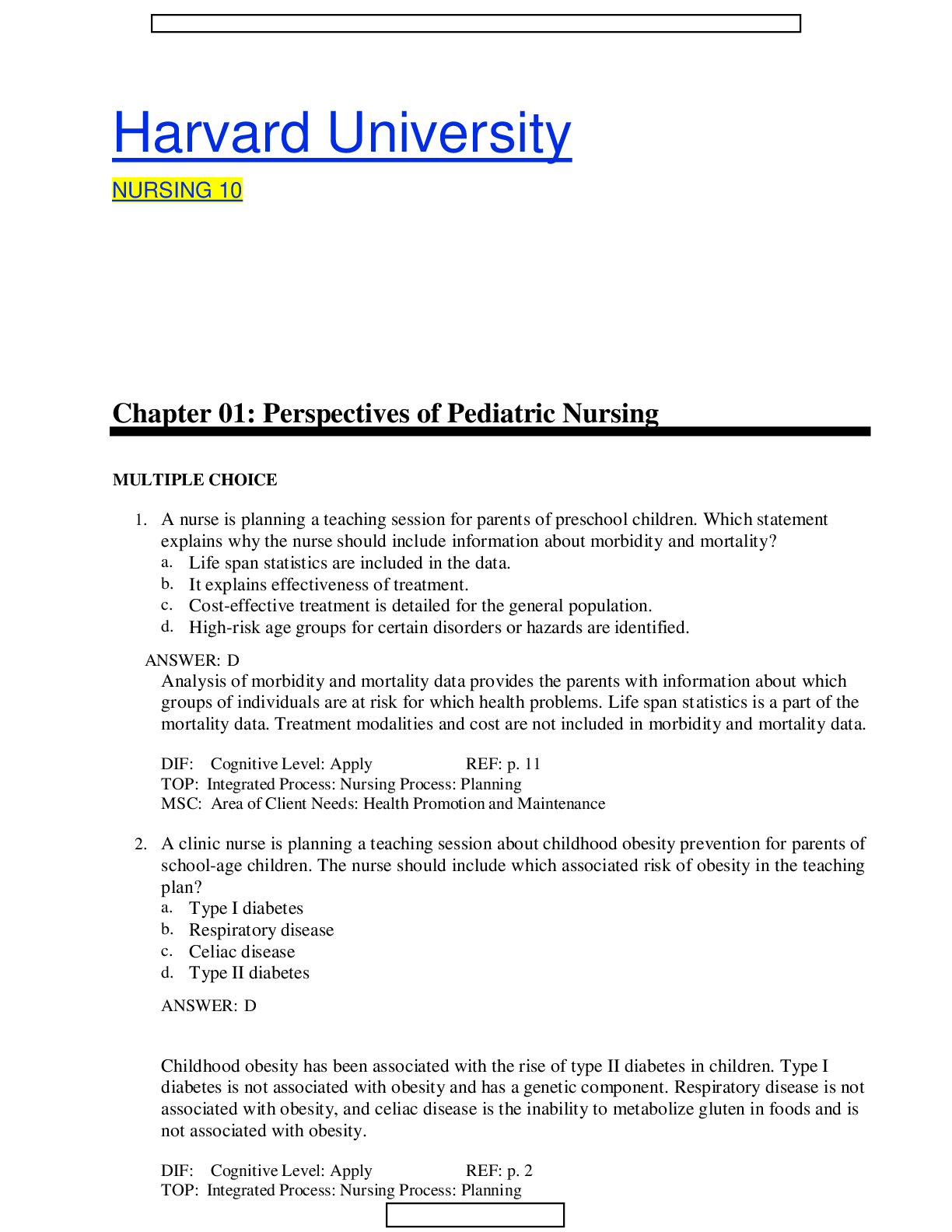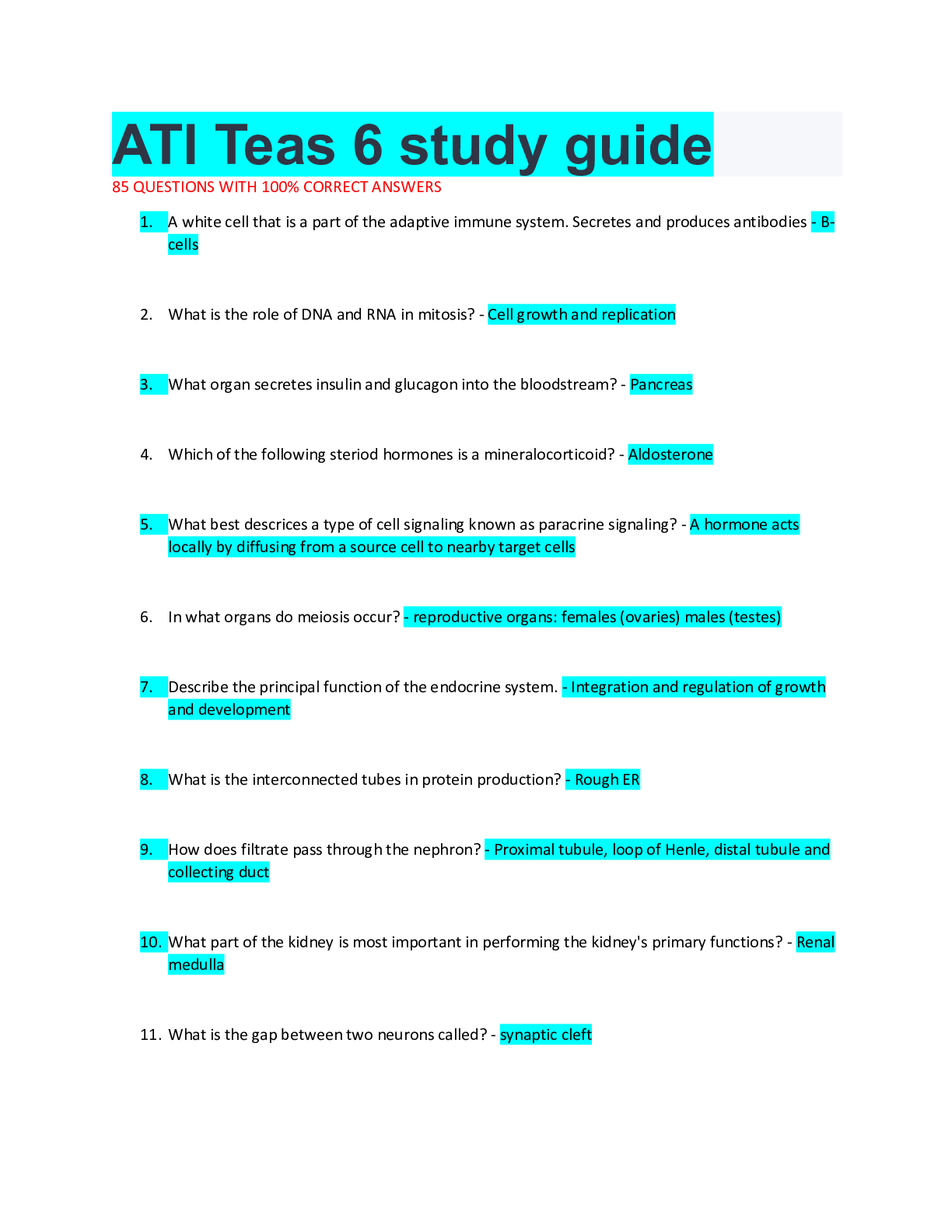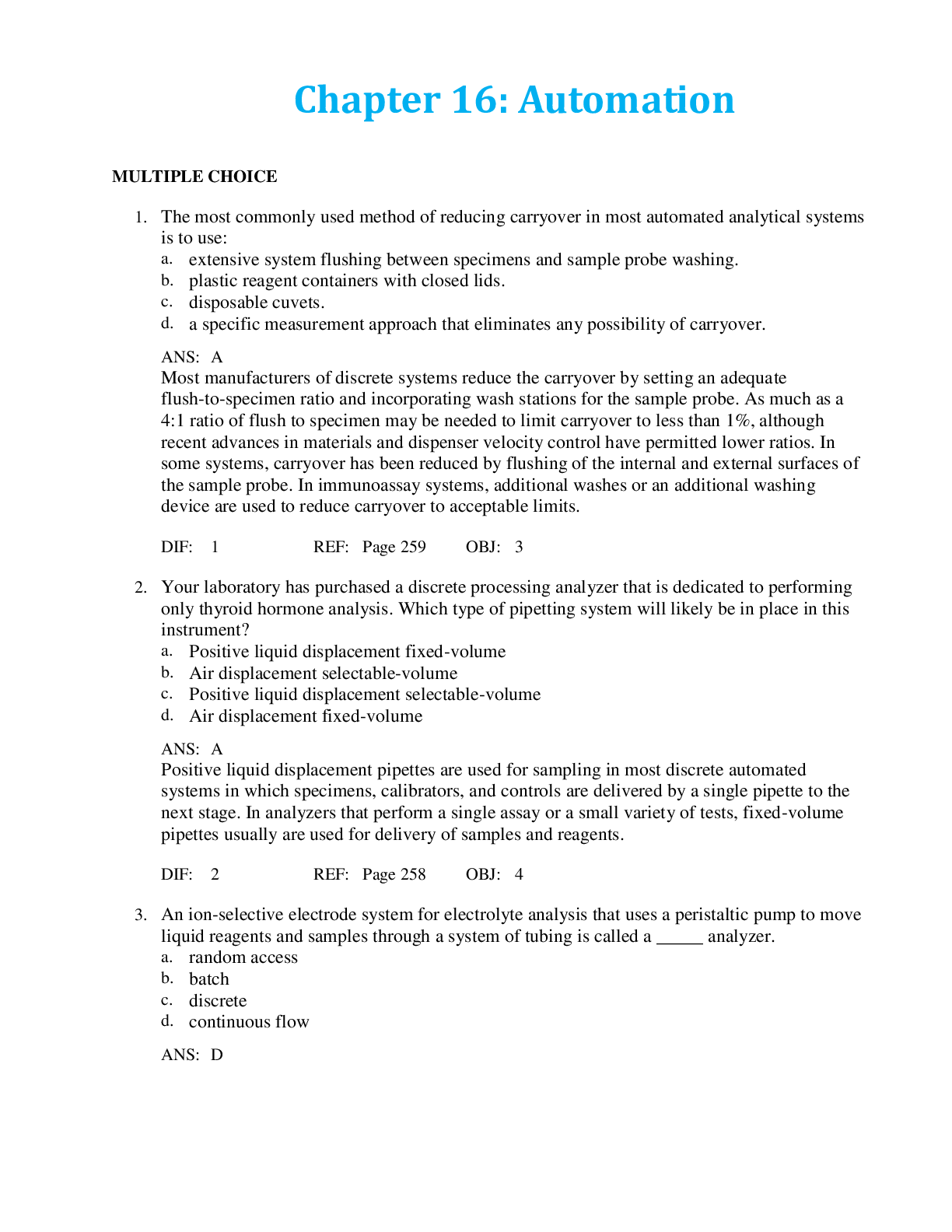
WONGS ESSENTIALS
$ 11.5

ATI Teas 6 study guide 85 QUESTIONS WITH 100% CORRECT ANSWERS
$ 12

test 1 study guide NURS 5366
Clinical Chemistry > QUESTIONS & ANSWERS > MLT230: Chapter 16: Automation. Answers Explained (All)
MULTIPLE CHOICE 1. The most commonly used method of reducing carryover in most automated analytical systems is to use: a. extensive system flushing between specimens and sample probe washing. b. ... plastic reagent containers with closed lids. c. disposable cuvets. d. a specific measurement approach that eliminates any possibility of carryover. 2. Your laboratory has purchased a discrete processing analyzer that is dedicated to performing only thyroid hormone analysis. Which type of pipetting system will likely be in place in this instrument? a. Positive liquid displacement fixed-volume b. Air displacement selectable-volume c. Positive liquid displacement selectable-volume d. Air displacement fixed-volume 3. An ion-selective electrode system for electrolyte analysis that uses a peristaltic pump to move liquid reagents and samples through a system of tubing is called a _____ analyzer. a. random access b. batch c. discrete d. continuous flow 4. The most significant improvement in the quality of laboratory test results can be attributed to the ability of automation to: a. reduce costs. b. increase work capacity. c. reduce error and variability caused by manual manipulation. d. reduce sample volumes and laboratory involvement. 5. In a chemiluminescent analyzer system: a. the excitation event that produces light is caused by a chemical reaction. b. reagents are impregnated on films or filter paper strips of the slide. c. the intensity of emitted light is directly proportional to the concentration of analyte. d. diffuse reflected light is measured. 6. What component causes carryover of the analyte in a discrete analytical system that uses disposable reaction vessels and measuring cuvets? a. The point at which sequential samples pass through b. The pipetting system c. The peristaltic pump d. The reagent delivery system 7. A tray of clear sample cups sits on a laboratory bench top for an extended period of time. Which one of the following analytes might be affected? a. Protein b. Cholesterol c. Glucose d. Bilirubin 8. The type of automated analyzer in which the operator is able to use in-house reagents or reagents purchased from suppliers different from the analyzer's manufacturer is referred to as a(n): a. discrete analyzer. b. random-access analyzer. c. open analyzer system. d. closed analyzer system. 9. In an automated laboratory workstation with a bidirectional laboratory information system interface, the laboratory’s bar-coded label on an individual specimen contains information regarding identification and the laboratory tests requested. The processor reads the bar code and the analyzer performs the analyses. Where can a preanalytical error still occur in this automated system? a. When the instrument’s calibration is not successful b. When the quality control materials are out of the recommended range c. When a data entry person enters incorrect laboratory test requests d. When the equipment operator ignores equipment diagnostic messages 10. Using whole blood as the specimen of choice in an automated analytical system: a. essentially eliminates specimen preparation time. b. allows the operator to use a secondary tube for analysis. c. keeps the specimen from undergoing degradation. d. allows for the avoidance of carryover. 11. The steps involved in the completion of an automated analytical process are collectively referred to as: a. aliquots. b. unit operations. c. instrument clusters. d. sequential analysis. 12. The point of interaction between the instrument operator and an automated analyzer that is dedicated to a defined task and is monitored by integrated computers is the: a. instrument cluster. b. work cell. c. conveyor belt. d. workstation. 13. The 80% rule of thumb that is used by some laboratories in guiding decisions regarding automating a complete laboratory to achieve cost reduction means: a. if 80% of the specimen handling situation can be standardized and automated, then the investment in automation is justified. b. that 80% of a laboratory's income will have to be dedicated to the implementation and upkeep of all automated processes. c. if 80% of the individuals involved in the laboratory process agree, then automation will be implemented. d. approximately 80% of individuals will have to give up their jobs. TRUE/FALSE 1. If programmed appropriately, a multiple-channel analyzer could assess samples as a single-channel analyzer. 2. Specimen bar coding has allowed for the ability of a system operator to place specimens in random sequence, thereby eliminating the need for specimen load lists. [Show More]
Last updated: 3 years ago
Preview 1 out of 5 pages

Buy this document to get the full access instantly
Instant Download Access after purchase
Buy NowInstant download
We Accept:

Can't find what you want? Try our AI powered Search
Connected school, study & course
About the document
Uploaded On
Feb 26, 2020
Number of pages
5
Written in
All
This document has been written for:
Uploaded
Feb 26, 2020
Downloads
0
Views
202
Scholarfriends.com Online Platform by Browsegrades Inc. 651N South Broad St, Middletown DE. United States.
We're available through e-mail, Twitter, Facebook, and live chat.
FAQ
Questions? Leave a message!
Copyright © Scholarfriends · High quality services·